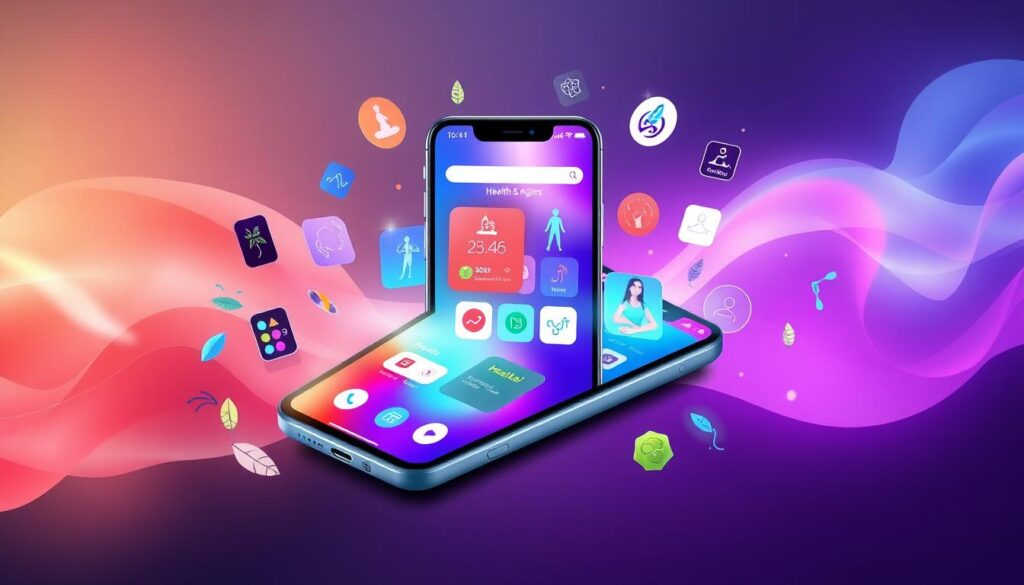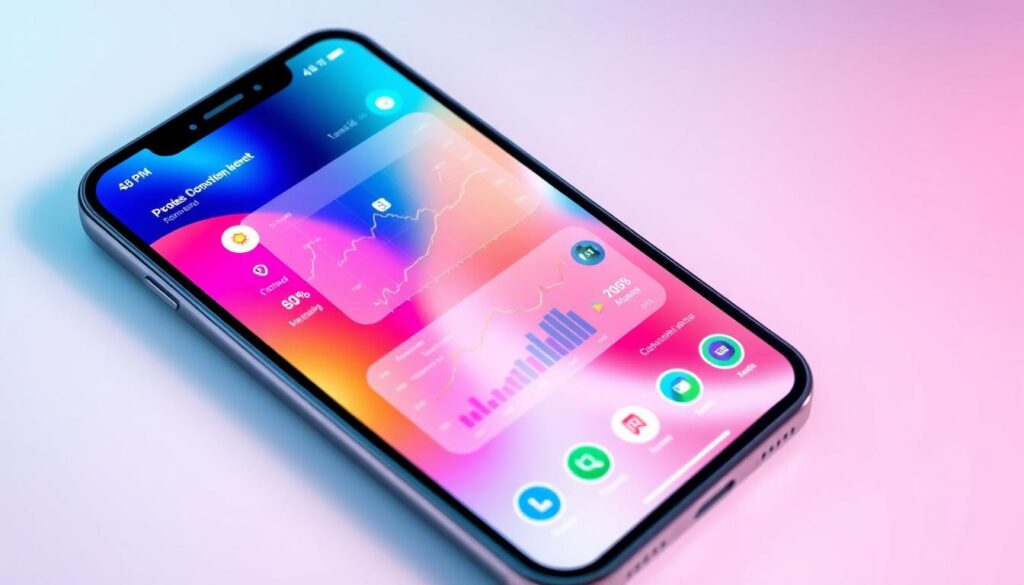Looking ahead to 2025, it’s key to know the latest app trends. These include AI, no-code platforms, and augmented reality. These trends will change how we make and use apps.
They aim to make apps better, easier to use, and more profitable for developers. The latest trends will focus on improving user experiences and app development.
The demand for mobile apps is growing fast. It’s important to keep up with new trends and tech. The app industry will see more ways to make money, like microtransactions and gamification.
Marketers will also explore new channels, like TikTok and influencer marketing. We’ll look at AI, no-code platforms, and other trends that will shape the app world in 2025.
Key Takeaways
- The top app trends for 2025 include AI integration, no-code/low-code platforms, sustainability, and augmented reality.
- These mobile app trends will enhance user experiences, improve app development, and increase revenue opportunities for developers.
- The latest app trends will focus on hyper-personalization, with businesses leveraging AI to adapt every interaction and enhance loyalty.
- The app industry is expected to see a rise in revenue diversification strategies, focusing on microtransactions, gamification, and personalized offers.
- Industry leaders indicate that marketers will diversify beyond traditional platforms to gain access to broader channels, including TikTok and influencer marketing.
- The adoption of 5G technology in mobile apps is expected to decrease loading times by approximately 90%, enhancing streaming and multiplayer experiences.
- Personalized AI models anticipate user needs, with an expected 30% increase in user engagement due to tailored recommendations and adaptive functionalities.
Introduction to App Trends
Exploring app development, I see how vital it is to keep up with app development trends. The field is always changing, driven by new tech and what users want. The Internet of Things market hit $318 billion in 2023, with mobile apps making up $226 billion. This number is set to grow, with IoT tech revenue hitting $1.6 trillion by 2025.
The latest podcast episodes highlight how new tech affects app design trends. For example, 5G connections have surged, with a 3.5 times jump in 2021. This boost means apps that use 5G’s power, like better video and games, are in demand. Looking ahead, trends like wearable tech, beacon tech, and mobile payments will shape the future.
Some trends to watch include more motion design, like in the Domino’s app, which boosted sales by 23%. Also, low-code platforms are growing, expected to hit $65 billion by 2027. This makes app-making easier, even for those without coding skills. Keeping up with app development trends is key for success.
AI Integration in Mobile Apps
Mobile apps are changing fast, thanks to AI. This shift is part of the popular app trends that are changing the app world. AI helps make apps more user-friendly and fun, offering content and help that fits each user’s needs.
Looking ahead, AI will make apps even better. Already, 65% of people want apps that know them. AI can make apps more engaging, with personalized tips boosting user interest by up to 20%. The app industry trends also show AI can make apps work better, saving time and effort by 40%.
Personalized User Experiences
AI lets apps give users what they want. Machine learning helps apps understand what users like, offering content and tips that match. For example, Netflix’s AI keeps 80% of its users hooked, showing AI’s power in making apps personal.
Advanced Customer Support Features
AI chatbots are changing how apps help users. They can talk like humans, answering questions quickly and making users happier by up to 40%.
Predictive Analytics for App Development
AI is also big in app making. It looks at user data to help developers make better apps. This leads to happier users and more money for apps.
In short, AI in mobile apps is a big deal. It’s part of the popular app trends, future app trends, and app industry trends. As apps keep getting smarter, our experiences with them will get even better.
The Rise of No-Code/Low-Code Platforms
The no-code/low-code platform market is booming, with a forecasted value of $21.2 billion by 2025. This surge is fueled by the growing need for mobile apps and the desire for businesses to create them fast and efficiently. As a result, app development trends are moving towards no-code/low-code options. These allow non-tech users to build apps without needing to know how to code.
No-code/low-code platforms offer many advantages. They cut down on development time, boost productivity, and save costs. Companies using these platforms have seen a 70% reduction in app development time compared to traditional coding. Small businesses have also seen a 50% increase in operational productivity with no-code solutions.
Some key app design trends in no-code/low-code platforms include:
- Customizable templates and drag-and-drop interfaces
- Integration with artificial intelligence and machine learning capabilities
- Robust security measures and compliance features
The emerging app trends in no-code/low-code platforms are expected to keep growing. More businesses are adopting these solutions to stay ahead. As the market evolves, we’ll see new innovations and advancements in no-code/low-code technology. This will change how we develop and design applications.
Increased Focus on Sustainability
Looking at the latest app trends, we see a big push for sustainability. More people want apps that help them live greener. The top app trends for 2025 will include apps for tracking carbon and promoting recycling.
Apps that focus on sustainability are becoming more popular. They attract users who care about the planet. Features like tracking energy use, finding eco-friendly products, and supporting green causes are big hits.
Some key stats show how important sustainability is in app development:
- A big increase in demand for apps with green features
- More people will use apps to track carbon and recycle
- A growing number of users want to make eco-friendly choices
By adding green features, developers can help the environment and keep users coming back. As we move forward, top app trends will focus on sustainability. Developers who get on board will likely do well.
| App Feature | Expected Adoption Rate |
|---|---|
| Energy usage tracking | High |
| Sustainable shopping suggestions | Medium |
| Contributions to environmental causes | High |
The Expansion of Augmented Reality (AR)
As I explore app development trends, I see a big move towards Augmented Reality (AR) in mobile apps. The AR market is set to hit $198 billion by 2025. This is thanks to AR and generative AI working together, making digital content creation 40% more efficient. This tech is changing how we interact with info and each other, especially in gaming and retail.
AR in gaming is making experiences better, with the AR gaming market growing 20% yearly. Retail AR, like virtual try-ons, could make up over 30% of online shopping by 2024. As app design trends keep changing, we’ll see AR used in more areas, like education and healthcare.
Some key stats show AR’s growth:
- 85% of marketers think AR is better for engaging consumers than old media.
- The smartphone AR market is growing 20% each year, thanks to better phone tech.
- AR apps will make user interaction 50% better than non-AR ones.
In summary, AR is changing how we interact with info and each other. As AR tech gets better, we’ll see it used in more areas, like gaming, retail, education, and healthcare.
| Industry | AR Application | Projected Growth |
|---|---|---|
| Gaming | Enhanced user experience | 20% CAGR from 2023 to 2025 |
| Retail | Virtual try-ons | Over 30% of online shopping experiences by 2024 |
| Education | Enhanced learning retention rates | 75% increase in learning retention rates |
Security and Privacy Enhancements
Looking at the latest popular app trends, it’s clear that security and privacy are key. App developers focus on keeping user data safe. They use advanced security like encryption and authentication, following future app trends.
Some important security features include:
- End-to-end encryption
- Advanced authentication methods, such as passwordless solutions and behavioral biometrics
- Regular security updates and patches
Blockchain technology is also being used to boost app security. It helps in creating a safe and open way to handle user data. As app industry trends grow, we’ll see more creative security solutions.

In summary, making apps secure and private is crucial for popular app trends and future app trends. By focusing on these areas, developers can keep user data safe. This builds trust and loyalty in the app industry trends.
| Security Feature | Description |
|---|---|
| End-to-end encryption | A method of secure communication that encrypts data at the sender’s end and decrypts it at the receiver’s end |
| Advanced authentication methods | Methods of verifying user identity, such as passwordless solutions and behavioral biometrics |
| Regular security updates and patches | Regular updates and patches to fix security vulnerabilities and ensure the app remains secure |
Popularity of Subscription-Based Models
As I explore app development trends, I see a big move towards subscription models. This trend helps both developers and users. It lets developers earn steady income and users get premium content.
Subscription models have many benefits. They give developers a steady income, which means they can update their apps faster. For users, it means they get to keep using the service and get feedback quickly. This builds strong, lasting relationships with customers.
Some key benefits include:
- Lower customer retention spend
- Enhanced demand forecasting accuracy
- Opportunities for upselling and cross-selling
In 2023, subscription apps made about $45.6 billion, up 11.4% from 2022. The trend is growing, with digital content and media subscriptions expected to grow by 13.5% from 2021 to 2025.
The move from buying once to subscribing is a big trend. Many businesses are choosing subscriptions for a steady income. It’s important to keep up with these trends and use them in your app strategy.
| Year | Revenue (in billion USD) |
|---|---|
| 2022 | 41.1 |
| 2023 | 45.6 |
Cross-Platform Development
Exploring latest app trends shows cross-platform development is key. Developers aim to make apps for many platforms, ensuring a smooth user experience. This is where cross-platform development shines, making apps work on different devices and platforms.
Top trends in cross-platform development include frameworks like Flutter, React Native, and Kotlin Multiplatform. These tools offer benefits like code-sharing, native-like performance, and faster app release. For instance, Flutter helped build eBay and Google Pay, while React Native powered Facebook and Instagram.
Businesses see the value in cross-platform development. It can cut development costs by up to 30% and speed up app release times. Frameworks like Flutter and React Native also ensure apps perform well, closing the gap with native apps.
Here are some key frameworks for cross-platform development:
- Flutter
- React Native
- Kotlin Multiplatform
- Ionic
- .NET MAUI
- NativeScript
In summary, cross-platform development is vital in the mobile app trends world. Businesses are embracing it to save time and money. With frameworks like Flutter and React Native, developers can craft apps that work seamlessly across various platforms.
| Framework | Release Year | Notable Apps |
|---|---|---|
| Flutter | 2017 | eBay, Google Pay |
| React Native | 2015 | Facebook, Instagram |
| Kotlin Multiplatform | 2017 | McDonald’s, Netflix |
Health and Wellness App Boom
The health and wellness app market is growing fast. This growth is thanks to emerging app trends that focus on mental health and fitness. The global consumer wellness market is now worth $1.8 trillion. In the United States, the wellness market has hit $480 billion.
This boom is driven by people wanting wellness apps that track their fitness and lifestyle. These apps are a big part of the latest app development trends.
Some important stats show the rise of health and wellness apps:
- Wearable devices like smartwatches and fitness trackers are expected to sell 240 million units by 2025.
- Use of fitness apps is set to increase by 35% in the next two years.
- Fitness apps are projected to make $15.7 billion in revenue by 2026.
These trends show the huge potential for app design trends in health and wellness. They highlight the importance of emerging app trends that focus on user needs and personal experiences.

Community-Centric App Development
As I explore app development, I see a big shift towards focusing on communities. This change is because of the need for popular app trends that make users feel involved. By building a community, developers can get a loyal group of users who help the app grow.
The future app trends include adding social features. These let users talk to each other and share their thoughts. Forums, discussion boards, and gamification are some ways to do this. This makes the app a lively place where users help it succeed.
In the app industry trends, focusing on communities is key. Developers now see how important user feedback and engagement are. By listening to users, apps can meet their needs better, making users happier and more loyal.
Some important strategies for community-focused app development are:
- Crowdsourcing ideas and feedback from users
- Adding social features for user interaction
- Using gamification and rewards to get users involved
By using these strategies, developers can make apps that stand out in today’s market. It’s crucial to keep up with popular app trends, future app trends, and app industry trends to succeed.
| App Development Strategy | Benefits |
|---|---|
| Community-Centric Development | More user engagement, better feedback, and stronger app loyalty |
| Social Feature Integration | Makes users interact, gets them involved, and builds a community |
| Crowdsourcing Ideas and Feedback | Gives valuable insights, drives innovation, and keeps development user-focused |
Voice User Interfaces (VUIs)
As I explore app development trends, I see a big move towards voice user interfaces (VUIs). More apps are using VUIs, showing how app design is changing. Now, apps can be controlled by voice, making things easier and more convenient.
VUIs in apps are becoming more popular and will likely keep growing. The Voice User Interface (VUI) market is expected to soar, hitting $27.16 billion by 2026. This is thanks to more smart home devices, speakers, and virtual assistants using VUIs.
Some key benefits of VUIs include:
- Enhanced user experience through hands-free navigation
- Increased accessibility for users with disabilities
- Improved task completion speed and productivity
As VUIs get better, we’ll see new ways they’re used in apps. It’s crucial for developers to keep up and use VUIs in their work.
Conclusion: What Lies Ahead
The world of mobile app development is set for big changes by 2025. New tech like artificial intelligence (AI), augmented reality (AR), and cloud computing will lead the way. Developers need to be quick to adapt to these top app trends to make apps that really stand out.
AI and machine learning will change how apps interact with users. They will make apps smarter and more personal. Also, no-code/low-code platforms will make app-making easier for more people. This means more ideas can turn into apps.
The need for sustainability and security in apps will also grow. This will change how apps are designed and how data is kept safe. These changes will make apps better for everyone.
The future of apps is full of possibilities. By keeping up with these latest app trends, developers can lead the way. They will create apps that amaze users and help businesses grow.



